Jewish religious movements
Jewish religious movements, sometimes called "denominations" or "branches", include different groups which have developed among Jews from ancient times. Today, the main division is between the "traditional Judaism" (Orthodox and Conservative), and Reform, with several smaller movements alongside them. This denominational structure is mainly present in the United States, while in Israel, the fault lines are between Haredi Judaism (Haredim), Religious Zionism (Datim), Masortim (traditional) and Hiloni (secular) Jews.[1]
| Part of a series on |
| Judaism |
|---|
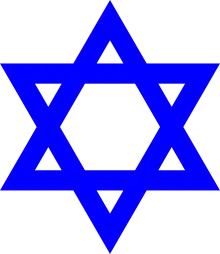 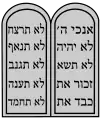  |
|
| Part of a series on |
| Jews and Judaism |
|---|
 |
|
The movements differ in their views on various issues. These issues include the level of observance, the methodology for interpreting and understanding Jewish law, biblical authorship, textual criticism, and the nature or role of the messiah (or messianic age). Across these movements, there are marked differences in liturgy, especially in the language in which services are conducted, with the more traditional movements emphasizing Hebrew. The sharpest theological division occurs between Orthodox and non-Orthodox Jews who adhere to other denominations, such that the non-Orthodox movements are sometimes referred to collectively as the "liberal denominations" or "progressive streams".
Terminology
Some Jews reject the term denomination as a label for different groups and ideologies within Judaism, arguing that the notion of denomination has a specifically Christian resonance that does not translate easily into the Jewish context. However, in recent years the American Jewish Year Book has adopted "denomination", as have many scholars and theologians.[2]
Commonly used terms are movements,[3][4][5][6][7][8] as well as denominations,[2][9] varieties,[10] traditions,[11] groupings,[7] streams, branches, trends, and such.
The Jewish groups themselves reject characterization as sects. Sects are traditionally defined as religious subgroups that have broken off from the main body, and this separation usually becomes irreparable over time. Within Judaism, individuals and families often switch affiliation, and individuals are free to marry one another, although the major denominations disagree on who is a Jew. It is not unusual for clergy and Jewish educators trained in one of the liberal denominations to serve in another, and left with no choice, many small Jewish communities combine elements of several movements to achieve a viable level of membership.
Relationships between Jewish religious movements are varied; they are sometimes marked by interdenominational cooperation outside of the realm of halakha (Jewish law), such as the New York Board of Rabbis, and sometimes not. Some of the movements sometimes cooperate by uniting with one another in community federations and in campus organizations such as the Hillel Foundation. Jewish religious denominations are distinct from, but often linked to, Jewish ethnic divisions and Jewish political movements.
Samaritanism
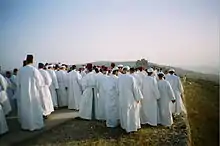
The Samaritans regard themselves as direct descendants of the tribes of Ephraim and Manasseh in the northern Kingdom of Israel, which was conquered by Assyria in 722 BCE.[12] Modern genetics has suggested some truth to both the claims of the Samaritans and of the Jews in account to the Talmud.[13]
Samaritan Torah preserves a version of the Torah in slightly variant forms. The first historical references to the Samaritans date from the Babylonian Exile. According to the Talmud, Samaritans are to be treated as Jews in matters where their practice agrees with the mainstream but are otherwise to be treated as non-Jews. The Samaritans have dwindled to two communities of about 700 individuals. One such community is located in the Israeli city of Holon, while the other is located near Nablus on Mount Gerizim, in the West Bank.[12]
Today, Samaritans need to officially go through formal conversion to Judaism in order to be considered Jewish. One example is Israeli TV personality Sofi Tsedaka who was brought up Samaritan and converted to Judaism at the age of 18.[14]
Sects in the Second Temple period
Prior to the destruction of the Second Temple in 70 CE, Jews of the Roman province of Judaea were divided into several movements, sometimes warring among themselves: Pharisees, Sadducees, Essenes, Zealots, and ultimately early Christians. Many historic sources such as Flavius Josephus, the New Testament and the recovered fragments of the Dead Sea Scrolls, attest to the divisions among Jews at this time. Rabbinical writings from later periods, including the Talmud, further attest these ancient schisms.[15]
The main internal struggles during this era were between the Pharisees and the Sadducees, as well as the early Christians, and also the Essenes and Zealots. The Pharisees wanted to maintain the authority and traditions of classical Torah teachings and began the early teachings of the Mishna, maintaining the authority of the Sanhedrin, the supreme Jewish court. According to Josephus, the Sadducees differed from the Pharisees on a number of doctrinal grounds, notably rejecting ideas of life after death. They appear to have dominated the aristocracy and the temple, but their influence over the wider Jewish population was limited. The Essenes preached an ascetic way of life. The Zealots advocated armed rebellion against any foreign power such as Rome. All were at violent logger-heads with each other, leading to the confusion and disunity that ended with the destruction of the Second Temple and the sacking of Jerusalem by Rome. The Jewish Christians were the original Jewish followers of Jesus. The radical interpretation of Moses' Law by Jesus' disciples and their belief he is the Son of God, along with the development of the New Testament, ensured that Christianity and Judaism would become distinctively different religions.[15]
Rabbinic Judaism
Most streams of modern Judaism developed from the Pharisaic movement, which became known as Rabbinic Judaism (in Hebrew Yahadut Rabanit — יהדות רבנית) with the compilation of the Oral Torah into the Mishna. After the Bar Kokhba revolt and the destruction of the Second Temple the other movements disappeared from the historical record, yet the Sadducees probably kept on existing in a non-organized form for at least several more decades.[15][16]
Non-Rabbinic Judaism
.JPG.webp)
Non-Rabbinic Judaism—Sadducees, Karaite Judaism, Samaritanism, and Haymanot—contrasts with Rabbinic Judaism and does not recognize the Oral Torah as a divine authority nor the rabbinic procedures used to interpret Jewish scripture.[17]
Karaite Judaism
The tradition of the Qara'im survives in Karaite Judaism, started in the early 9th century when non-rabbinic sages like Benjamin Nahawandi and their followers took the rejection of the Oral Torah by Anan ben David to the new level of seeking the plain meaning of the Tanakh's text. Karaite Jews accept only the Tanakh as divinely inspired, not recognizing the authority that Rabbinites ascribe to basic rabbinic works like the Talmud and the Midrashim.[18][19]
Ethno-cultural divisions' movements
Although there are numerous Jewish ethnic communities, there are several that are large enough to be considered predominant. Generally, they do not constitute a separate religious branches within Judaism, but rather a separate cultural tradition (nusach) and rite of prayer (minhag). Ashkenazi Jews compose about 75% of the world's Jewish population. Sephardi Jews and Mizrahi Jews compose the greatest part of the rest, with about 20% of the world's Jewish population. Israel has two Chief Rabbi—one for the Ashkenazic, another for the Sephardic with Mizrahi Jews.[20] The remaining 5% of Jews are divided among a wide array of small groups (such as the Beta Israel group of Ethiopian Jews who follow the Haymanot branch of Judaism), some of which are nearing extinction as a result of assimilation and intermarriage into surrounding non-Jewish cultures or surrounding Jewish cultures.
The Enlightenment had a tremendous effect on Jewish identity and on ideas about the importance and role of Jewish observance. Due to the geographical distribution and the geopolitical entities affected by the Enlightenment, this philosophical revolution essentially affected only the Ashkenazi community; however, because of the predominance of the Ashkenazi community in Israeli politics and in Jewish leadership worldwide, the effects have been significant for all Jews.
Sephardic and Mizrahi Judaism
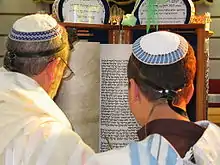
"Sephardic Judaism' is the practice of Judaism as observed by the Sephardim (Spanish and Portuguese Jews). The Mizrahi Jews (including Maghrebi) are all Oriental Jewry. Some definitions of "Sephardic" also include Mizrahi, many of whom follow the same traditions of worship but have different ethno-cultural traditions. So far as it is peculiar to themselves and not shared with other Jewish groups such as the Ashkenazim (German rite).[21][22]
Sephardim are primarily the descendants of Jews from the Iberian Peninsula. They may be divided into the families that left in the Expulsion of 1492 and those that remained as crypto-Jews, Marranos and those who left in the following few centuries. In religious parlance, and by many in modern Israel, the term is used in a broader sense to include all Jews of Ottoman or other Asian or African backgrounds (Mizrahi Jews), whether or not they have any historic link to Spain, although some prefer to distinguish between Sephardim proper and Mizraḥi Jews.
Sephardic and Mizrachi Jewish synagogues are generally considered Orthodox or Sephardic Haredim by non-Sephardic Jews, and are primarily run according to the Orthodox tradition, even though many of the congregants may not keep a level of observance on par with traditional Orthodox belief. For example, many congregants will drive to the synagogue on the Shabbat, in violation of halakha, while discreetly entering the synagogue so as not to offend more observant congregants.
Unlike the predominantly Ashkenazic Reform, and Reconstructionist denominations, Sephardic and Mizrahi Jews who are not observant generally believe that Orthodox Judaism's interpretation and legislation of halakha is appropriate, and true to the original philosophy of Judaism. That being said, Sephardic and Mizrachi rabbis tend to hold different, and generally more lenient, positions on halakha than their Ashkenazi counterparts, but since these positions are based on rulings of Talmudic scholars as well as well-documented traditions that can be linked back to well-known codifiers of Jewish law, Ashkenazic and Hasidic Rabbis do not believe that these positions are incorrect, but rather that they are the appropriate interpretation of halakha for Jews of Sephardic and Mizrachi descent.[21][22]
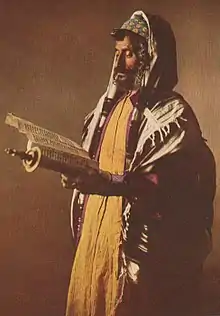
The Yemenite Jews—the Dor Daim and other movements—use a separate Baladi-rite. The Yemenite and the Aramaic speaking Kurdish Jews are the only communities who maintain the tradition of reading the Torah in the synagogue in both Hebrew and the Aramaic Targum ("translation"). Most non-Yemenite synagogues have a specified person called a Baal Koreh, who reads from the Torah scroll when congregants are called to the Torah scroll for an aliyah. In the Yemenite tradition, each person called to the Torah scroll for an aliyah reads for himself.[23]
The Shas, a religious political party in Israel, represents the interests of the Orthodox/Haredi Sephardim and Mizrahim.[24]
Hasidic Judaism
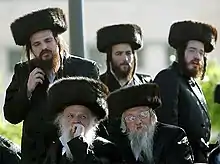
Hasidic Judaism was founded by Israel ben Eliezer (1700–1760), also known as the Baal Shem Tov, who had previously called themselves Freylechn ("happy ones") and now call themselves Hasidim ("pious, holy ones"). His charismatic disciples attracted many followers among Ashkenazi Jews, and established numerous Hasidic groups across Europe. The Baal Shem Tov came at a time when the Jewish masses of Eastern Europe were reeling in bewilderment and disappointment engendered by the two notorious Jewish false messiahs, Sabbatai Zevi (1626–1676) and Jacob Frank (1726–1791), and their respective followers. Hasidic Judaism eventually became the way of life for many Jews in Eastern Europe. The Hasidim are organized in independent "courts" or dynasties, each headed by its own hereditary spiritual leader-rebbe. Unlike other Ashkenazim, most Hasidim use some variation of Nusach Sefard, a blend of Ashkenazi and Sephardi liturgies, based on the innovations of Kabbalist Isaac Luria. Neo-Hasidism is trends of interest in the teachings of Kabbalah and Hasidism by members of other existing Jewish movements.[25]
Lithuanian (Lita'im)
In the late 18th century, there was a serious schism between Hasidic and non-Hasidic Jews. European Jews who rejected the Hasidic movement were dubbed Mitnagdim ("opponents") by the followers of the Baal Shem Tov. Lithuania became the centre of this opposition under the leadership of Vilna Gaon (Elijah ben Solomon Zalman), which adopted the epithets Litvishe (Yiddish word), Litvaks (in Slavic) or Lita'im (in Hebrew) those refers to Haredi Jews who are not Hasidim (and not Hardalim or Sephardic Haredim). Since then, all the groups of Hasidic Judaism have been subsumed theologically into mainstream Orthodox Judaism, particularly Haredi Judaism, although cultural differences persist. The Lithuanian spirituality mainly incorporated into the Musar movement.[7][26][27]
Post-Enlightenment movements
Late-18th-century Europe, and then the rest of the world, was swept by a group of intellectual, social and political movements that taken together were referred to as the Enlightenment. These movements promoted scientific thinking, free thought, and allowed people to question previously unshaken religious dogmas. The emancipation of the Jews in many European communities, and the Haskalah movement started by Moses Mendelssohn, brought the Enlightenment to the Jewish community.
In response to the challenges of integrating Jewish life with Enlightenment values, German Jews in the early 19th century began to develop the concept of Reform Judaism, adapting Jewish practice to the new conditions of an increasingly urbanized and secular community. Staunch opponents of the Reform movement became known as Orthodox Jews. Later, members of the Reform movement who felt that it was moving away from tradition too quickly formed the Conservative movement.[28] At same time, the notion "traditional Judaism" includes the Orthodox with Conservative[7] or solely the Orthodox Jews.[8]
Over time, three main movements emerged (Orthodoxy, Conservatism, Reformism)[7][8]
Orthodoxy
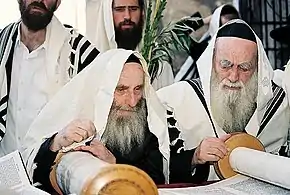
Orthodox Jews generally see themselves as practicing normative Judaism, rather than belonging to a particular movement. Within Orthodox Judaism, there is a spectrum of communities and practices, ranging from ultra-Orthodox Haredi Judaism (Haredim) and Jewish fundamentalism to Modern Orthodox Judaism (with Neo-Orthodoxy, Open Orthodoxy, and Religious Zionism). Orthodox Jews who opposed the Haskalah became known as Haredi Jews (Haredim). Orthodox Jews who were sympathetic to the Haskalah formed what became known as neo-Orthodox or modern Orthodox Jews.[29][30][31] The father of neo-Orthodoxy was the influenced German rabbi Samson Raphael Hirsch, who proclaimed principle Torah im Derech Eretz—the strict observance of the Jewish Law in an active social life—in 1851, he become the rabbi of first Orthodox separatist group from Reform community of Frankfurt am Main.[32][33] In addition, the "Centrist" Orthodoxy was represented by American rabbi Joseph B. Soloveitchik affiliated with the Orthodox Union.[34]
In Israel, Orthodox Judaism occupies a privileged position: solely an Orthodox rabbi may become the Chief rabbi and Chief military rabbi; exclusively conversion to Orthodox Judaism is recognized for the purposes of the Law of Return; and only Orthodox synagogues have the right to conduct Jewish marriages.[30]
Conservatism (Masorti)
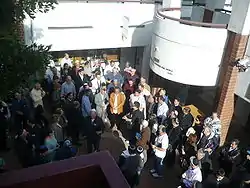
Conservative or Masorti Judaism, originated in Germany in the 19th century, but became institutionalized in the United States, where it was to become the largest Jewish movement.[8] After the division between Reform and Orthodox Judaism, the Conservative movement tried to provide Jews seeking liberalization of Orthodox theology and practice with a more traditional and halakhically-based alternative to Reform Judaism. It has spread to Ashkenazi communities in Anglophone countries and Israel.[35][6]
Reformism
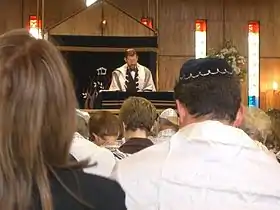
Also known as Liberal or Progressive Judaism. Originally began in Germany and the Netherlands circa 1820 as a reaction to modernity, stresses assimilation and integration with society and a personal interpretation of the Torah.[3][36][5][37][38]
Migration
The particular forms which the denominations have taken on have been shaped by immigration of the Ashkenazi Jewish communities, once concentrated in eastern and central Europe, to western and mostly Anglophone countries (in particular, in North America). In the middle of the 20th century, the institutional division of North American Jewry between Reform, Conservative, and Orthodox movements still reflected immigrant origins. Reform Jews at that time were predominantly of German or western European origin, while both Conservative and Orthodox Judaism came primarily from eastern European countries.[39]
Zionists (Datim) and anti-Zionists

The issue of Zionism was once very divisive in the Jewish community. Religious Zionism combines Zionism and Orthodox Judaism, based on the teachings of rabbis Zvi Hirsch Kalischer and Abraham Isaac Kook. The name Hardalim ("Nationalist Haredim") refers to the Haredi-oriented variety of Religious Zionism.[40] Another mode is Reform Zionism as Zionist arm of Reform Judaism.
Religious Zionists (datim) have embraced the Zionist movement, including Religious Kibbutz Movement, as part of the divine plan to bring or speed up the messianic era.[7]
Ultra-Orthodox Jewish non-Zionists believed that the return to Israel could only happen with the coming of the Messiah, and that a political attempt to re-establish a Jewish state through human means alone was contrary to God's plan. Non-Zionists believed that Jews should integrate into the countries in which they lived, rather than moving to the Land of Israel. The original founders of Reform Judaism in Germany rejected traditional prayers for the restoration of Jerusalem. The view among Reform Jews that Judaism was strictly a religion rather than a nation with cultural identity, and that Jews should be assimilated, loyal citizens of their host nations, led to a non-Zionist, and sometimes anti-Zionist, stance. After events of the 20th century, most importantly the Holocaust and the establishment of the modern State of Israel, opposition to Zionism largely disappeared within Reform Judaism.
Among most religious non-Zionists, such as Chabad, there is a de facto recognition of Israel, but only as a secular non-religious state.
A few of the fringe groups of the anti-Zionists does not recognize the legitimacy of the Israeli state. Among them are both the Orthodox (Satmar hasids, Edah HaChareidis, Neturei Karta) and Reform (American Council for Judaism).[7]
Pressures of assimilation
Among the most striking differences between the Jewish movements in the 21st century is their response to pressures of assimilation, such as intermarriage between Jews and non-Jews.[41] Reform and Reconstructionist rabbis have been most accepting of intermarried couples, with some rabbis willing to officiate in mixed religious ceremonies, although most insist that children in such families be raised strictly Jewish. Conservative rabbis are not permitted to officiate in such marriages, but are supportive of couples when the non-Jewish partner wishes to convert to Judaism and raise children as Jewish.[42]
Beta Israel (Haymanot)
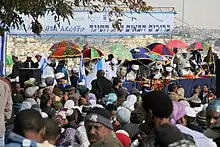
The Beta Israel (House of Israel), also known as Ethiopian Jews, are a Jewish community that developed and lived for centuries in Ethiopia. Most of them emigrated to Israel in the late 20th century. They practiced Haymanot (Religion), which are generally recognized as a non-Rabbinic Judaism (in Israel practicing both Haymanot and Rabbinic Judaism). The holiest book is the Orit (meaning "law"), which consists of the Torah with Joshua, Judges and Ruth. The Beta Israel of Ethiopia were the only modern Jewish group with a monastic tradition where the monks lived separated from the Jewish villages in monasteries existed until the middle of the 20th century.[43]
Crypto-Judaism
The secret adherence to Judaism while publicly professing to be of another faith; practitioners are referred to as "crypto-Jews" (origin from Greek kryptos – κρυπτός, 'hidden').
In the United States Reform rabbi Jacques Cukierkorn is one of the leaders of the outreach to the descendants of those Crypto-Jews who wish to renew their ties with the Jewish people.[44]
Other ethnic
A movement of Jews of Russian ethnic origin which split off from other Sabbatarians in the late 18th century. Them majority belonged to Rabbinic and Karaite Judaism, the minority to Spiritual Christianity.[45][46] Subbotnik families settled in the Holy Land at the time part of the Ottoman Empire, in the 1880s, as part of the Zionist First Aliyah in order to escape oppression in the Russian Empire and later mostly intermarried with other Jews. Their descendants included Israeli Jews such as Alexander Zaïd, Major-General Alik Ron,[47] and the mother of Ariel Sharon.[48]
20th/21st-centuries movements
20th-century movements
Additionally, a number of smaller groups have emerged:
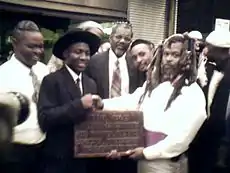
It is Judaism that predominantly practiced by African communities, both within the African Continent and outside Africa (such as North America). It is theologically characterized by the selective acceptance of the Judaic faith (in some cases such selective acceptance has historical circumstances), and that the belief system of Black Judaism is significantly different from the mainstream movements of Judaism. In addition, although Black Judaic communities adopt Judaic practices such as Jewish holidays and Jewish prayers, some of them are generally not recognized by the mainstream Jewish societies as legitimately Jewish.[49]
A movement in the Kingdom of Hungary and in its territories ceded in 1920, which is similar to the more traditional branch of American Conservative Judaism.[50]
Formed in the early 20th century by Alfred G. Moses and Morris Lichtenstein. Jewish Science was founded as a counterweight Jewish movement to Christian Science. Jewish Science sees God as a force or energy penetrating the reality of the Universe and emphasis is placed upon the role of affirmative prayer in personal healing and spiritual growth. The Society of Jewish Science in New York is the institutional arm of the movement regularly publishing The Interpreter, the movement's primary literary publication.[51]
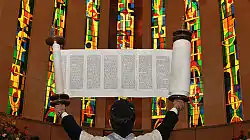
A 1920s – 1940s-founded by rabbi Mordecai Kaplan split from Conservative movement that views Judaism as a progressivelly evolving civilization with focus on Jewish community.[52][53] The central organization is "Reconstructing Judaism". Assessments of its impact range from being recognized as the 4th major stream of Judaism[8] to described as a smallest movement.[54]
A nontheistic worldwide movement that emphasizes Jewish culture and history as the sources of Jewish identity. Originated in Detroit in 1965 with the founding figure, Reform rabbi Sherwin Wine, in 1969 was established the Society for Humanistic Judaism.[55]
The neo-Hasidic movement inspired by the counterculture of the 1960s and founded in the late 1960s in San Francisco (where opened the House of Love and Prayer), then in Israel, by a musician, Lubavich's Hasidic rabbi Shlomo Carlebach for the return of secular youth to the bosom of Orthodox Judaism. The movement has no organisational agenda and promotes Carlebach minyan, a song-fill form of Jewish worship.[56][57]
Partly syncretistic movement founded in the mid-1970s by ex-Lubavich's Hasidic rabbi Zalman Schachter-Shalomi and rooted out of the counterculture of the 1960s and the Havurat Shalom group. The "Bnei ʻOr" (Songs of Light) in Philadelphia—the first Renewal community—later was established the ambrella organisation "ALEPH: the Alliance for Jewish Renewal". Its syncretism includes Kabbalah, neo-Hasidism, Reconstructionist Judaism, Western Buddhist meditation, Sufism, New Age, feminism, liberalism, and so on, tends to embrace the ecstatic worship style. Renewal congregations tend to be inclusive on the subject of who is a Jew and had avoided affiliation with any Jewish communities.[56][58]
The term occasionally applied to describe either individuals or new congregations, aspecially established by rabbi David Weiss Halivni in 1984 in US Union for Traditional Judaism, located between the Conservative and Modern Orthodox.[59][60] While most scholars consider "Union for Traditional Judaism" (formerly Union for Traditional Conservative Judaism) as a new movement, some attribute it to the right wing of Conservative Judaism.[61]
A New Age worldwide organisation established in 1984 by American rabbi Philip Berg, that popularizes Jewish mysticism among universal audience.[62][63]
A Haredi cult formed in the 1980s by Israeli-Canadian rabbi Shlomo Helbrans, follows a strict version of halakha, including its own unique practices such as lengthy prayer sessions, arranged marriages between teenagers, and head-to-toe coverings for females.[64]
A movement founded by Avi Weiss in the late 1990s in US, with its own schools for religious ordination, both for men (Yeshivat Chovevei Torah) and women (Yeshivat Maharat). The movement declarates liberal, or inclusive Orthodoxy with women's ordination, full accepting LGBT members, and reducing stringent rules for conversion.[65]
Is a controversial ultra-Orthodox group with a Jewish burqa-style covering of a woman's entire body, including a veil covering the face.[66]
Made up of followers who seek to combine parts of Rabbinic Judaism with a belief in Jesus as the Messiah and other Christian beliefs. It is not regarded as Judaism by the scholars and the major movements of Judaism, and is considered a form of Protestant Christianity.[note 1] People who had become Messianic Jews as, in fact, Christians were not therefore eligible for Aliyah under the Law of Return.[68]
The baal teshuva movement is a description of the return of secular Jews to religious Judaism and involved with all the Jewish movements.
Trans- and post-denominational Judaism
The very idea of Jewish denominationalism is contested by some Jews and Jewish non-denominational organisations, which consider themselves to be "trans-denominational" or "post-denominational".[58][69][70] The term "trans-denominational" also applied to describe new movements located on the religious continuum between some major streams, as an instance, Conservadox (Union for Traditional Judaism).[59][60]
A variety of new Jewish organisations are emerging that lack such affiliations:
- Havurah movement is the number of small egalitarian experemintal spiritual groups (first in 1960 in California) for prayer as autonomous alternatives to Jewish movements. Most notable of them is the Havurat Shalom in Somerville, Massachusetts;[58]
- Independent minyan movement is a lay-led Jewish worship and study community that has developed independently of established denominational and synagogue structures and combines halakha with egalitarianism;[71]
- International Federation of Rabbis (IFR), a non-denominational rabbinical organization for rabbis of all movements and backgrounds;[70]
- Some Jewish day schools lack affiliation with any one movement;[72][70]
- There are several seminaries which are not controlled by a denomination:
- Academy for Jewish Religion (AJRCA) is a transdenominational seminary based in Los Angeles, California. It draws faculty and leadership from all denominations of Judaism. It has programs for rabbis, cantors, chaplains, community leadership and Clinical Pastoral Education (CPE);[70]
- Academy for Jewish Religion (New York) (AJR) is a transdenominational seminary in Yonkers, NY, that trains rabbis and cantors and also offers Master's Program in Jewish Studies;
- Hebrew College seminary, in Newton Centre, Massachusetts, near Boston;[70]
- The ALEPH Ordination Program (AOP), a non-denominational Jewish renewal seminary training rabbis, cantors, rabbinic pastors, and Jewish spiritual directors.[73]
Organizations such as these believe that the formal divisions that have arisen among the "denominations" in contemporary Jewish history are unnecessarily divisive, as well as religiously and intellectually simplistic. According to Rachel Rosenthal, "the post-denominational Jew refuses to be labeled or categorized in a religion that thrives on stereotypes. He has seen what the institutional branches of Judaism have to offer and believes that a better Judaism can be created."[74] Such Jews might, out of necessity, affiliate with a synagogue associated with a particular movement, but their own personal Jewish ideology is often shaped by a variety of influences from more than one denomination.
Bnei Noah
Noahidism, Noahides, or Bnei Noah (Hebrew: בני נח, "Sons of Noah") is a new religious movement which is based upon the Seven Laws of Noah. Historically, the Hebrew term Bnei Noah has been applied to all non-Jews because Jews believe that they are the descendants of Noah.[75] Nowadays However, it is specifically used to refer to those "Righteous Gentiles" who observe the Seven Laws of Noah. According to Jewish law, non-Jews (Gentiles) are not obligated to convert to Judaism, but they are required to observe the Seven Laws of Noah in order to be assured that they will have a place in the World to Come (Olam Ha-Ba), the final reward of the righteous. The modern Noahide movement was founded in the 1990s by Orthodox rabbis from Israel (mainly tied Hasidic and Zionist).[76][77]
List of contemporary movements
- Orthodox Judaism
- Haredi Judaism (ultra-Orthodox)
- Hardal
- Hasidic Judaism
- Misnagdim (Lithuanian)
- Sephardic Haredim
- Yemenite Judaism
- Other Haredim
- Modern Orthodoxy
- Haredi Judaism (ultra-Orthodox)
- Conservadox
- Conservative Judaism (Masorti)
- Reform Judaism
- Other Rabbinic
- Non-Rabbinic Judaism
- Anusim
- Allahdad
- Beta Abraham
- Chala (Jews)
- Converso
- Dönmeh
- Kaifeng Jews
- Marrano
- Mashhadi Jews
- Neofiti
- Xueta
- Others
- Syncretic[note 2]
See also
Notes
- "Messianic Judaism is a Protestant movement that emerged in the last half of the 20th century among believers who were ethnically Jewish but had adopted an Evangelical Christian faith.…By the 1960s, a new effort to create a culturally Jewish Protestant Christianity emerged among individuals who began to call themselves Messianic Jews."[67]
- Jewish syncretic new religious movements those are not recognized as Judaism by Israel's rabbinate and worldwide Rabbinic Jewry.
References
- "Israel's Religiously Divided Society". Pew Research Center's Religion & Public Life Project. 2016-03-08. Retrieved 2020-02-23.
- Sarna, Jonathan D. (2004). American Judaism: A History. New Haven, Conn: Yale University Press. pp. xix–xx notes the "newfound popularity" of the term "denomination". ISBN 9780300129106.
- Philipson, David (1907). The Reform Movement in Judaism. London; New York: Macmillan. Archived from the original on 2009-06-16.
- Cohen, Arthur A.; Mendes-Flohr, Paul, eds. (2009) [1987]. 20th Century Jewish Religious Thought: Original Essays on Critical Concepts, Movements, and Beliefs. JPS: The Jewish Publication Society. ISBN 978-0-8276-0892-4.
- Meyer, Michael A. (1988). Response to Modernity: A History of the Reform Movement in Judaism. New York: Oxford University Press. ISBN 9780195051674.
- Elazar, Daniel J.; Geffen, Rela Mintz (2012). The Conservative Movement in Judaism: Dilemmas and Opportunities. New York: SUNY Press. ISBN 9780791492024.
- Jacobs, Louis (2007). "Judaism". In Fred Skolnik (ed.). Encyclopaedia Judaica. 11 (2nd rev. ed.). Farmington Hills, MI: Macmillan Reference USA. ISBN 978-002-865-928-2.
- Mendes-Flohr, Paul (2005). "Judaism". In Thomas Riggs (ed.). Worldmark Encyclopedia of Religious Practices. 1. Farmington Hills, MI: Thomson Gale. ISBN 9780787666118.
- Lazerwitz, Bernard Melvin; Winter, J. Alan; Dashefsky, Arnold; Tabory, Ephram (1998). Jewish Choices: American Jewish Denominationalism. SUNY series in American Jewish Society in the 1990s. New York: SUNY Press. ISBN 978-0-7914-3581-6.
- Blau, Joseph L. (1966). Modern Varieties of Judaism. New York: Columbia University Press. ISSN 0075-8531.
- Lee, Raphael Marc (1984). Profiles in American Judaism: the Reform, Conservative, Orthodox, and Reconstructionist traditions in historical perspective. San Francisco, CA: Harper & Row. ISBN 0-06066801-6.
- Mor, Menachem; Reiterer, Friedrich V.; Winkler, Waltraud, eds. (2010). Samaritans: Past and Present: Current Studies. Studia Samaritana, 5 & Studia Judaica, 53. Berlin: De Gruyter. ISBN 978-3-11-019497-5.
- Oefner, Peter; et al. (2004). "Reconstruction of Patrilineages and Matrilineages of Samaritans and Other Israeli Populations From Y-Chromosome and Mitochondrial DNA Sequence Variation". Human Mutation. 24 (3): 248–260. doi:10.1002/humu.20077. PMID 15300852. S2CID 1571356.
- "אחרי הפיצוץ הגדול: סופי צדקה מתפייסת עם השומרונים" [After the big explosion: Sophie Izedaka reconciles with the Samaritans]. nrg (in Hebrew). 2010-09-12. Retrieved 2014-11-09.
- Schiffman, Lawrence H. (2003). Jon Bloomberg; Samuel Kapustin (eds.). Understanding Second Temple and Rabbinic Judaism. Jersey, NJ: KTAV. ISBN 9780881258134.
- "Rabbinic Judaism". Encyclopædia Britannica Online. Retrieved 2020-11-07.
- Sela, Shulamit (1994). The Head of the Rabbanite, Karaite and Samaritan Jews: On the History of a Title, Bulletin of the School of Oriental and African Studies, University of London. Vol. 57, No. 2. pp. 255–267.
-
 This article incorporates text from a publication now in the public domain: Kohler, Kaufmann; Harkavy, Abraham de (1901–1906). "Karaites and Karaism". In Singer, Isidore; et al. (eds.). The Jewish Encyclopedia. New York: Funk & Wagnalls.CS1 maint: multiple names: authors list (link)
This article incorporates text from a publication now in the public domain: Kohler, Kaufmann; Harkavy, Abraham de (1901–1906). "Karaites and Karaism". In Singer, Isidore; et al. (eds.). The Jewish Encyclopedia. New York: Funk & Wagnalls.CS1 maint: multiple names: authors list (link) - Yaron, Y.; Pessah, Joe; Qanaï, Avraham; El-Gamil, Yosef (2003). An Introduction to Karaite Judaism: History, Theology, Practice and Culture. Albany, NY: Qirqisani Center. ISBN 978-0-9700775-4-7.
- Himelstein, Shmuel (2011). "Chief Rabbinate". The Oxford Dictionary of the Jewish Religion (2nd ed.). Oxford; New York: Oxford University Press. p. 166. ISBN 978-0-19-973004-9.
- Dobrinsky, Herbert C. (1988). A treasury of Sephardic laws and customs: the ritual practices of Syrian, Moroccan, Judeo-Spanish and Spanish and Portuguese Jews of North America. Revised ed. Hoboken, NJ: KTAV; New York, N.Y.: Yeshiva Univ. Press. ISBN 0-88125-031-7
- Weiner, Rebecca. "Judaism: Sephardim". Jewish Virtual Library. A Project of AICE. Retrieved 2020-11-07.
- Simon, Reeva; Laskier, Michael; Reguer, Sara (eds.) (2002). The Jews of the Middle East and North Africa In Modern Times, Columbia University Press, s.v. Chapters 8 and 21.
- Skolnik, Fred, ed. (2007). "Shas". Encyclopaedia Judaica. 18 (2nd rev. ed.). Farmington Hills, Mich.: Macmillan Reference USA. pp. 419–420. ISBN 978-002-865-928-2.
- Assaf, David. "Hasidism: Historical Overview". YIVO Encyclopedia of Jews in Eastern Europe. YIVO Institute for Jewish Research. Retrieved 2020-11-25.
- Nadler, Allan (1997). The Faith of the Mithnagdim: Rabbinic Responses to Hasidic Rapture. Johns Hopkins Jewish studies. Baltimore, MD: Johns Hopkins University Press. ISBN 9780801861826.
- Nadler, Allan. "Misnagdim". YIVO Encyclopedia of Jews in Eastern Europe. YIVO Institute for Jewish Research. Retrieved 2020-11-02.
- Lazerwitz et al. 1998, pp. 15–24.
- Lee 1984, pp. 125–176.
- Skolnik, Fred, ed. (2007). "Orthodoxy". Encyclopaedia Judaica. 12. Farmington Hills, MI: Macmillan Reference USA. pp. 1486–93. ISBN 978-002-865-928-2.
- Silber, Michael K. "Orthodoxy". YIVO Encyclopedia of Jews in Eastern Europe. YIVO Institute for Jewish Research. Retrieved 2012-08-15.
- Schweid, Eliezer (1984–1985). Translated by Yohanan Eldad. "Two Neo-Orthodox Responses to Secularization. Part I: Samson Raphael Hirch" (PDF). Immanuel (19): 107–117.
- Liberles, Robert (1985). Conflict in Social Context: The Resurgence of Orthodox Judaism in Frankfurt am Main, 1838–1877. Contributions to the Study of Religion, 13. Westport, Conn.: Greenwood Press. ISSN 0196-7053.
- Bernstein, Saul (1997). The Orthodox Union Story: A Centenary Portrayal. Northvale, NJ: Jason Aronson. ISBN 9780765799531.
- Lee 1984, pp. 79–124.
- Plaut, W. Gunther (1963). The Rise of Reform Judaism: A Sourcebook of its European Origins. World Union for Progressive Judaism. OCLC 39869725.
- Lee 1984, pp. 1–78.
- Kaplan, Dana Evan (2007). "Reform Judaism". In Fred Skolnik (ed.). Encyclopaedia Judaica. 17 (2nd rev. ed.). Farmington Hills, MI: Macmillan Reference USA. ISBN 978-002-865-928-2.
- Herberg, Will (1983). Protestant, Catholic, Jew: An Essay in American Religious Sociology. University Of Chicago Press (Reprint edition). ISBN 0-226-32734-5. OCLC 9686985.
- Ticker, Jay (1975). The Centrality of Sacrifices as an Answer to Reform in the Thought of Zvi Hirsch Kalischer. Working Papers in Yiddish and East European Studies, vol. 15. New York: YIVO Institute for Jewish Research.
- Tobin, Gary A. and Katherine G. Simon (1999). Rabbis Talk About Intermarriage. Institute for Jewish and Community Research. ISBN 1-893671-00-3. OCLC 44759291.
- Bloom, Mark; et al. (2004). A Place In The Tent: Intermarriage And Conservative Judaism. Eks Publishing. ISBN 0-939144-46-8. OCLC 179259677.
- "Beta Israel". Encyclopædia Britannica Online. Retrieved 2020-11-07.
- Chicago Jewish Cafe (2018-10-03), Are American Jews the New Secret Jews? Interview with Rabbi Jacques Cukierkorn., retrieved 2018-10-08
-
 This article incorporates text from a publication now in the public domain: Rosenthal, Herman; Hurwitz, S. (1901–1906). "Subbotniki ("Sabbatarians")". In Singer, Isidore; et al. (eds.). The Jewish Encyclopedia. New York: Funk & Wagnalls.CS1 maint: multiple names: authors list (link)
This article incorporates text from a publication now in the public domain: Rosenthal, Herman; Hurwitz, S. (1901–1906). "Subbotniki ("Sabbatarians")". In Singer, Isidore; et al. (eds.). The Jewish Encyclopedia. New York: Funk & Wagnalls.CS1 maint: multiple names: authors list (link) - Dynner, Glenn (2011). Holy Dissent: Jewish and Christian Mystics in Eastern Europe. Wayne State University Press. pp. 358–9. ISBN 9780814335970.
- Dr. Ruchama Weiss ▪ Rabbi Levi Brackman, "Russia's Subbotnik Jews get rabbi", Ynet, December 9, 2010. Retrieved 2015-08-22.
- Itamar Eichner (March 11, 2014). "Subbotnik Jews to resume aliyah". Israel Jewish Scene. Archived from the original on 2014-04-09. Retrieved 2014-04-09.
- Landing, James E. (2002). Black Judaism: Story of an American Movement. Durham, NC: Carolina Academic Press. ISBN 978-0-89089-820-8.
- Silvan, Gabriel (2011). "Neology". In Berlin, Adele (ed.). The Oxford Dictionary of the Jewish Religion (2nd ed.). Oxford; New York: Oxford University Press. p. 533. ISBN 978-0-19-973004-9.
- Umansky, Ellen M. (2005). From Christian Science to Jewish Science: Spiritual Healing and American Jews. New York: Oxford University Press. ISBN 0-19-504400-2.
- Lee 1984, pp. 177–194.
- Alpert, Rebecca (2011). "Judaism, Reconstructionist". The Cambridge Dictionary of Judaism and Jewish Culture. Cambridge University Press. p. 346.
- Niebuhr, Gustav (January 18, 1997). "A Jewish Movement Takes Stock of Itself at Age 40". The New York Times.
- Cohn-Sherbok, Dan (2006). "Humanistic Judaism". In Clarke, Peter B. (ed.). Encyclopedia of new religious movements. London; New York: Routledge. pp. 288–289. ISBN 9-78-0-415-26707-6.
- Magid, Shaul (2005). "Jewish Renewal Movement" (PDF). In Jones, Lindsay (ed.). The Encyclopedia of Religion. 7 (2nd ed.). Farmington Hills, MI: Macmillan Reference USA. pp. 4868–74. ISBN 0-02-865740-3.
- Magid, Shaul (2013). American Post-Judaism: Identity and Renewal in a Postethnic Society. Religion in North America. Bloomington: Indiana University Press. pp. 233–239. ISBN 9780253008022.
- Magid 2013.
- Ament, Jonathon (2004). The Union for Traditional Judaism: A Case Study of Contemporary Challenges to a New Religious Movement (PhD thesis). Waltham, Mass.: Department of Near Eastern and Jewish Studies, Brandeis University.
- Michaelson, Jay (October 13, 2006). "Old Labels Feel Stiff for 'Flexidox'"". The Jewish Daily Forward.
- Lazerwitz et al. 1998, p. 24.
- Puttick, Elizabeth (2006). "Kabbalah". In Clarke, Peter B. (ed.). Encyclopedia of new religious movements. London; New York: Routledge. pp. 322–323. ISBN 9-78-0-415-26707-6.
- Myers, Jody Elizabeth (2007). Kabbalah and the spiritual quest: the Kabbalah Centre in America. Westport, Conn: Praeger. ISBN 978-0-275-98940-8.
- Fogelman, Shay (March 9, 2012). "Lev Tahor: Pure as the driven snow, or hearts of darkness?". Haaretz. Archived from the original on 2014-05-17. Retrieved 2014-05-29.
- Ginsberg, Johanna (August 16, 2017). "Closing A Chapter On 'Open Orthodoxy'". The New York Jewish Week. Retrieved 2020-12-30.
- "A Jewish Movement to Shroud the Female Form". NPR. March 17, 2008. Archived from the original on July 29, 2018. Retrieved February 27, 2019.
- Melton, J. Gordon (2005). Encyclopedia of Protestantism, Infobase Publishing. ISBN 978-0-8160-5456-5. p. 373.
- "Israeli Court Rules Jews for Jesus Cannot Automatically Be Citizens". The New York Times. December 27, 1989. Archived from the original on 2008-05-23. Retrieved 2010-05-07.
- Heilman, Uriel (February 11, 2005). "Beyond Dogma". The Jerusalem Post.
- McHenry, Terry W. (2018). "Chapter 5.1.2 Judaism. Modern Religious Sects". Truth Versus Man'S Religious Systems. Xlibris US. ISBN 9781543470857.
- Salmon, Jackquelin L. (June 6, 2009). "New Judaism". The Washington Post.
- Mendelsohn, Martha (August 22, 2002). "High School Without Labels". The Jewish Week.
- ALEPH.org
- Rosenthal, Rachel (2006). "What's in a name?". Kedma (Winter).
-
 This article incorporates text from a publication now in the public domain: Singer, Isidore; Greenstone, Julius H. (1901–1906). "Noachian Laws". In Singer, Isidore; et al. (eds.). The Jewish Encyclopedia. New York: Funk & Wagnalls.CS1 maint: multiple names: authors list (link)
This article incorporates text from a publication now in the public domain: Singer, Isidore; Greenstone, Julius H. (1901–1906). "Noachian Laws". In Singer, Isidore; et al. (eds.). The Jewish Encyclopedia. New York: Funk & Wagnalls.CS1 maint: multiple names: authors list (link) - Feldman, Rachel Z. (October 8, 2017). "The Bnei Noah (Children of Noah)". World Religions and Spirituality Project. Archived from the original on 2020-01-21. Retrieved 2020-11-03.
- Feldman, Rachel Z. (August 2018). "The Children of Noah: Has Messianic Zionism Created a New World Religion?" (PDF). Nova Religio: The Journal of Alternative and Emergent Religions. 22 (1): 115–128. doi:10.1525/nr.2018.22.1.115 – via Project MUSE.
Further reading
- Berlin, Adele, ed. (2011). The Oxford Dictionary of the Jewish Religion (2nd ed.). Oxford; New York: Oxford University Press. ISBN 978-0-19-973004-9.
- Karesh, Sara E.; Hurvitz, Mitchell M. (2005). Encyclopedia of Judaism. Encyclopedia of World Religions. J. Gordon Melton, Series Editor. New York: Facts On File. ISBN 978-0-8160-6982-8.
- Skolnik, Fred, ed. (2007). Encyclopaedia Judaica. 1–22 (2nd rev. ed.). Farmington Hills, MI: Macmillan Reference USA. ISBN 978-002-865-928-2.
External links
| Wikimedia Commons has media related to Jewish denominations. |
| Wikisource has the text of the 1905 New International Encyclopedia article "Jewish Sects". |
- Emergence of Jewish Denominations (MyJewishLearning.com)
- Jewish World Today. Overview: State of the Denominations (MyJewishLearning.com)
- Jewing Movements - How Jewish movements will and have evolved
- Orthodox/Haredi
- Orthodox Judaism – The Orthodox Union
- Chabad-Lubavitch
- Rohr Jewish Learning Institute
- The Various Types of Orthodox Judaism
- Aish HaTorah
- Ohr Somayach
- Traditional/Conservadox
- Conservative
- The United Synagogue of Conservative Judaism
- Masorti (Conservative) Movement in Israel
- United Synagogue Youth
- Reform/Progressive
- The Union for Reform Judaism (USA)
- Reform Judaism (UK)
- Liberal Judaism (UK)
- World Union for Progressive Judaism (Israel)
- Reconstructionist
- Renewal
- Humanistic
- Karaite